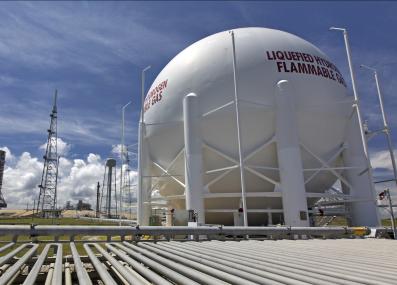Have a question?
Which is more likely: electric airplanes or hydrogen-powered airplanes?
For long-range flights with many passengers, liquid fuels like hydrogen are probably our best bet.
April 13, 2021
Airplanes burn a lot of dirty, carbon-emitting jet fuel to keep themselves airborne, making the aviation industry one of the biggest emitters of greenhouse gases. That’s why it is crucial to find cleaner ways to power our planes, says Steven Barrett, Professor of Aeronautics and Astronautics at MIT, director of the MIT Laboratory for Aviation and the Environment, and leader of the MIT Electric Aircraft Initiative.
One option could be aircraft that use rechargeable electric batteries, just as electric vehicles are beginning to replace some gasoline-powered cars. Several startup companies have begun building and testing battery-powered planes, and scientists are investigating far-out kinds of chemistry to pack more power into a battery and help those planes fly farther. But Barrett says electric airplanes have severe limitations. “Batteries are just physically too heavy for a longer-range aircraft,” he says. Even with major advances in battery technologies, Barrett sees electric planes being limited to short- or medium-range journeys, not lengthy flights over oceans or between distant cities. (An experimental solar-powered plane has flown around the world, but solar panels cannot gather and convert enough sunlight to be a good candidate for airliners anytime soon.)
That makes hydrogen, which can be stored as a liquid fuel and burned with only water as a byproduct, a more realistic path to cleaning up most air travel. Liquified hydrogen is “many times more energy-dense than even the most exotic battery,” Barrett says, and therefore lighter. However, says Barrett, building a future in which airlines fly on hydrogen would be a humongous challenge of engineering—not to mention fantastically expensive. Every airport would need a steady supply of hydrogen to refuel the jets that fly through, just as they must have huge quantities of jet fuel now. He estimates that each of those airports would need lots of extra energy—the equivalent of a small nuclear reactor’s worth—to create all that hydrogen. Barrett says governments probably would need to fund much of this work, because the aviation industry would hesitate to take on something so costly that won’t have an immediate payoff.
In the short term, Barrett says, there are half measures that work with the engines planes already have. The easiest renewable energy source to use in airplanes would be biofuels: liquid fuels created from plants. However, they contain less energy per gallon than jet fuel, and growing the plants to make them requires valuable land that could be used for something else. A more speculative option is to make synthetic jet fuel from hydrogen and carbon. Some chemical processes can combine the hydrogen in water with carbon from carbon dioxide (ideally CO2 captured from a factory or power plant) and make a fuel that works well in jet engines. Barrett doesn’t see these fuels as a long-term solution for cleaner airplanes, but as a short-term solution and part of a bridge to greener transportation.
Bridge fuels that current planes can burn may be crucial if we are to meet ambitious climate targets—like the goal of the global Paris Agreement to constrain global warming to under 2° Celsius. After all, airlines will be buying today’s aircraft for years to come, and will fly them for decades to make back the money they invested in the planes. “A lot of the planes we’ll be flying in 2050, when we need to get to net-zero, are already in the air,” Barrett says.
Thank you to Tom Carlson of Wenatchee, Washington, for the question. You can submit your own question to Ask MIT Climate here.
Submit your own question to Ask MIT Climate
Get the latest from Ask MIT Climate monthly in your inbox









